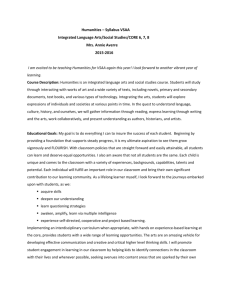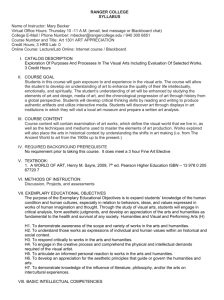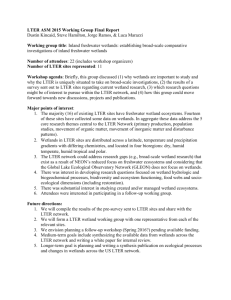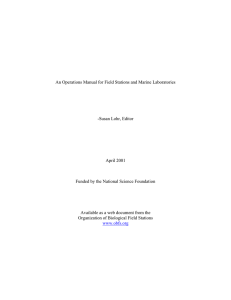Proposal
advertisement
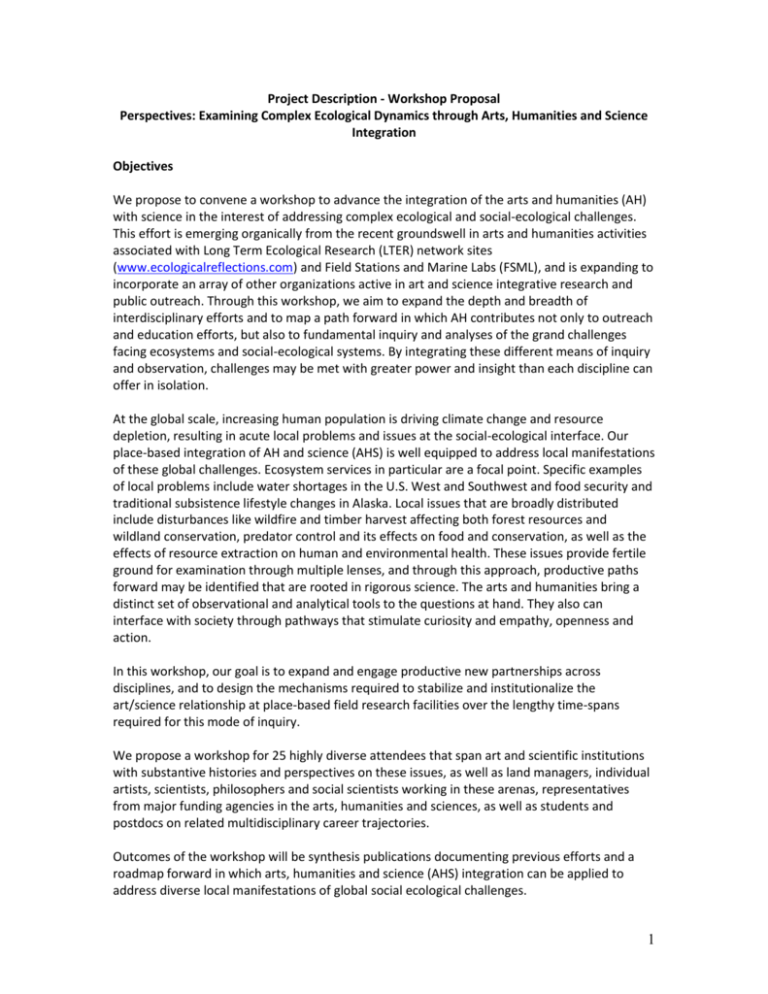
Project Description - Workshop Proposal Perspectives: Examining Complex Ecological Dynamics through Arts, Humanities and Science Integration Objectives We propose to convene a workshop to advance the integration of the arts and humanities (AH) with science in the interest of addressing complex ecological and social-ecological challenges. This effort is emerging organically from the recent groundswell in arts and humanities activities associated with Long Term Ecological Research (LTER) network sites (www.ecologicalreflections.com) and Field Stations and Marine Labs (FSML), and is expanding to incorporate an array of other organizations active in art and science integrative research and public outreach. Through this workshop, we aim to expand the depth and breadth of interdisciplinary efforts and to map a path forward in which AH contributes not only to outreach and education efforts, but also to fundamental inquiry and analyses of the grand challenges facing ecosystems and social-ecological systems. By integrating these different means of inquiry and observation, challenges may be met with greater power and insight than each discipline can offer in isolation. At the global scale, increasing human population is driving climate change and resource depletion, resulting in acute local problems and issues at the social-ecological interface. Our place-based integration of AH and science (AHS) is well equipped to address local manifestations of these global challenges. Ecosystem services in particular are a focal point. Specific examples of local problems include water shortages in the U.S. West and Southwest and food security and traditional subsistence lifestyle changes in Alaska. Local issues that are broadly distributed include disturbances like wildfire and timber harvest affecting both forest resources and wildland conservation, predator control and its effects on food and conservation, as well as the effects of resource extraction on human and environmental health. These issues provide fertile ground for examination through multiple lenses, and through this approach, productive paths forward may be identified that are rooted in rigorous science. The arts and humanities bring a distinct set of observational and analytical tools to the questions at hand. They also can interface with society through pathways that stimulate curiosity and empathy, openness and action. In this workshop, our goal is to expand and engage productive new partnerships across disciplines, and to design the mechanisms required to stabilize and institutionalize the art/science relationship at place-based field research facilities over the lengthy time-spans required for this mode of inquiry. We propose a workshop for 25 highly diverse attendees that span art and scientific institutions with substantive histories and perspectives on these issues, as well as land managers, individual artists, scientists, philosophers and social scientists working in these arenas, representatives from major funding agencies in the arts, humanities and sciences, as well as students and postdocs on related multidisciplinary career trajectories. Outcomes of the workshop will be synthesis publications documenting previous efforts and a roadmap forward in which arts, humanities and science (AHS) integration can be applied to address diverse local manifestations of global social ecological challenges. 1 Statement of need There is a long and recently intensified history of arts and humanities (AH) activities at Long Term Ecological Research (LTER) Sites, Field Stations and Marine Labs (FSMLs) (Swanson, submitted). Ecological research at these sites is highly place-based, long-term, and increasingly focuses on social-ecological interactions. There is a strong commitment to public outreach and education. These institutions are fertile grounds for AH engagement with science as well as the public. By combining AH with science (AHS), sites with active programs are making significant advances in public outreach and also discovering ways in which AH and science can work together to address today’s grand social-ecological challenges. Some sites of long-term ecological research and education have some notable successes in addressing tough environmental issues (e.g., leadership in future scenario projects and formulation of conservation strategies) and in engagement of arts and humanities, but cases of mustering arts-science teams to tackle challenging problems are exceedingly rare. This work tends to be individual and episodic, like much place-based field science of the past. FSML/LTER art activities also often overlay, rather than integrate with the science, focusing on broader impacts like outreach and illustration rather than tackling fundamental, complex problems of dynamic ecosystems in the context of dynamic social systems. Nonetheless, these sites with their sustained communities of inquiry and education offer exceptional venues for the slowpaced processes of growing trust among worldviews and connecting with larger societal contexts. Today, the purview of field science is growing as the environmental problems society faces also expand. Field science is becoming more networked, and expanding to landscape, continental and even global scales.The paradigm of scientific inquiry is undoubtedly highly powerful, yet is not optimized to address all dimensions of ecological dynamics in the Anthropocene era, in which human social systems are major drivers of ecological dynamics. The arts and humanities, and the numerous subdisciplines included in those generalized disciplinary headings (e.g. visual and performing arts, writing, philosophy, ethics), stand to offer a productive source of ideas and approaches to the grand challenges of this era. They can foster empathy, increase openness to science and empower society to access multiple sources of information as critical decisions are made related to land and resource management and conservation. Principle investigators of LTER sites have expressed support for AH activities at their sites for many reasons, and also agree that AH have great potential to advance science (Goralnik et al., 2015). When surveyed by Goralnik et al. (2015), 19 of 24 LTER site PIs agreed or strongly agreed that arts and humanities inquiry is important and relevant for the sites. PIs perceived AH to be important because the work is good in and of itself, because it successfully fosters public outreach and engagement in science, and because it can stimulate overall creativity. Respondents also recognized the power of AH and environmental ethics in fostering empathy in ways that can be valuable for addressing social-ecological challenges related to Earth stewardship. LTER PIs noted that the greatest challenges for AH work at sites are funding, time and available labor, expertise and clear vision of goals, and a lack of alignment with research (Goralnik et al., 2015). The existence of art and humanities at field research facilities often waxes and wanes based on the interest of individuals, many of whom are volunteers, rather than the institutional 2 mandates that drive science at these sites. There is rarely a sense of ownership of field research facilities by university arts and humanities departments or institutions, which could help in leadership and coordination. Unlike scientific data management, there is also currently not an organized distribution or archival mechanism to bring cohesion to the artwork emerging from these sites, or to make it available to inform future works of art and science. The sciences, engineering, arts and design network (SEAD) has examined these and other issues and reported them in a white paper (Malina et al., 2013). One aim of our workshop will be to develop roadmaps forward for increased and sustainable integration of AHS at sites of long-term ecological inquiry. The challenges of environmental change are huge and unprecedented. Addressing the grand challenges of our time will require a synthesis of multiple perspectives, including science, arts and the humanities. All of these fields share a common aim of exposing hidden truths about the world. They can also engage the public more successfully than can traditional scientific outreach methods. Synthesizing these perspectives on social-ecological challenges in the context of placebased and problem-focused research stands to yield much greater success in solving problems than separate disciplines working in relative isolation. List of workshop topics 1. The Grand Challenge: How can we integrate science with the arts and humanities to address the complex questions posed by ecological dynamics, and at a practical level, how can we apply the different tools, worldviews and philosophies of these disciplines to envision and solve complex problems? 2. Exchanging perspectives. “Walk a mile in the other’s shoes” – a brief exercise to gain appreciation of one another’s world view, spanning disciplines of arts, humanities and science. 3. Context and Case studies – brief overviews: State of arts-science linkage thinking Grand Challenges, global issues, local issues and common themes Successes to date – capacities of places/programs we wish to motivate Challenges faced by AHS programs and strategies for overcoming them 4. Framing unified mission and aims – what distinctive potentials do sustained places and communities bring? 5. Roadmap forward 6. Planning for future proposals (e.g. RCN) 7. Developing synthesis papers for publication 3 Recent meetings on the same subject Several meetings have been held on the general topic of arts-science synergies; we are capitalizing on advances made in these discussions and will conduct the proposed meeting to take a critical next step in advancing collaborations that address challenging topics from the base of long-term sites. ● ● ● ● The South American Institute for Resilience and Sustainability (SARAS) 2014 Workshop on Art Science Collaborations, December 15-17, 2014, and Public Conference on Art Science Collaborations, December 14-18, 2014; Maldonado, Uruguay. Organization of Biological Field Stations/National Association of Marine Laboratories Joint Annual Meeting, September, 2014; Wood’s Hole, MA. Working Group for Art@FSMLs formed. SymBIOtic ART & Science Conference: an investigation into the intersection of life sciences and the arts. Sponsored by the National Science Foundation and the National Endowment for the Arts. Feb 28-March 1, 2011 NSF, Arlington, VA The National Science Foundation Computer, Information Systems and Engineering directorate Intelligent Systems division (CISE IIS) sponsored three workshops in 2010 and 2011 bringing together artists, scientists and engineers from across the United States to address needs of the burgeoning community of researchers and practitioners that bridge Computer Science, Engineering and Creativity. Chairperson and members of organizing committees and their organizational affiliations Co-chairs ● Mary Beth Leigh, University of Alaska Fairbanks, Bonanza Creek LTER, Fairbanks, AK ● Faerthen Felix, University of California, Berkeley - Sagehen Creek Field Station Organizing Committee ● Frederick Swanson: Oregon State University and USFS, H.J. Andrews Experimental Forest and LTER, Corvallis, OR ● Lindsey Rustad: USFS, Northern Research Station, Durham, NH, Hubbard Brook Experimental Forest and LTER. ● Jeff Brown: UC Berkeley, Central Sierra Field Research Stations; OBFS/NAML ● Bill Fox, Colin Robertson and Sara Frantz: Nevada Museum of Art, Center for Art + Environment, Reno NV As academics and staff working at field research facilities, we are already attempting to identify and address these issues together. We are reaching out to each other, to artists, and to new partners in the institutional art, science, and public outreach worlds. Participants currently include representatives from the Organization of Biological Field Stations (OBFS) and the National Association of Marine Laboratories (NAML), LTERs, USFS Experimental Forests, universities, and the Nevada Museum of Art – Center for Art + Environment. We are talking to unconventional potential partners on both sides of the art-science divide; both those with deep, place-based experience and those whose thinking and work is not place-based. 4 5 Potential Workshop Invitees: Table 1. Top 25 potential workshop invitees. See Appendix A for additional candidates. Name Title Affiliation Bill Fox Director Nevada Museum of Art Reno, NV Center for Art + Environment Faerthen Felix Jeff Brown UC Berkeley, Sagehen Creek Field Station; Asst. Manager; Working Organization of Biological Group Coordinator Field Stations/National Assoc of Marine Labs UC Berkeley, Central Sierra Director Field Research Stations; OBFS/NAML Location Category Why this person? Arts Institution Extremely innovative program. Willing to provide meeting facility in-kind support, and introductory talk. Meeting co-planner. Truckee, CA Field Station Meeting planner Truckee, CA Field Station Meeting planner Fred Swanson Emeritus scientist HJ Andrews LTER, USFS, OBFS/NAML Corvallis, OR Mary Beth Leigh Associate Professor University of Alaska Fairbanks Fairbanks, AK Lindsey Rustad Team Leader, Research Hubbard Brook LTER, USFS ME Ecologist LTER and other sites with history of AH activities LTER with history of AH activities LTER with history of AH activities Meeting planner. Co-lead of LTER Network-wide AH activities. Meeting planner. Co-lead of LTER Network-wide AH activities. Meeting planner Sara Frantz Archivist Nevada Museum of Art Reno, NV Center for Art + Environment Colin Robertson Curator of Education Nevada Museum of Art Reno, NV Center for Art + Environment Arts Institution Ariane Koek Director Collide@CERN London, UK Science Institution Roger Malina Scientist and Editor Leonardo Magazine Dallas, TX Arts Institution Jerry Schubel Director Aquarium of the Pacific Los Angeles, CA Scientist Saran Twombly DEB Program Director NSF Washington D.C. Science Institution Carlos RodriguezFranco Assoc. Deputy Chief, R&D US Forest Service, Washington Office Arlington, VA Bill O'Brien Senior Advisor for Program Innovation NEA Washington D.C. Arts Institution Eva Caldera Assistant Chairman for Partnership and Strategic Initiatives NEH Washington D.C. Arts Institution Holly Sidford President Helicon Consulting New York, NY Arts Institution Annie Duffy Artist, Ph.D. student University of Alaska Fairbanks Fairbanks, AK Artist, Curator, Student Lauren Bon Artist Metabolic Studio; Annenberg Los Angeles, CA Artist Foundation Board Social sculpture focus; major private funders of media and culture Ronald Feldman Gallery owner Professor, Earth and Planetary Science Professor, Integrated Biology Feldman Fine Arts New York, NY Arts Institution UC Berkeley Berkeley, CA Scientist Social sculpture focus National Academy of Science fellow; deeply familiar with FSML issues; art history background National Academy of Science fellow; deeply familiar with FSML issues; FSML manager Bill Dietrich Mary Power Neal Overstrom Nature Lab Director Janet Brown Executive Director Brandon Balengée Artist UC Berkeley - Angelo Coast Berkeley, CA Range Reserve Rhode Island School of Providence, RI Design (RISD) Grantmakers in the Arts Arts Institution Archivist of innovative art + ecology program. Assisting with meeting planning. Education curator of innovative art + ecology program. Assisting with meeting planning. Science institution Scientist Arts Institution Seattle, WA Arts Institution New York, NY Artist Impressive and visionary art/science program Working at the intersection of art and science for decades National Academy of Science fellow; deeply familiar with FSML issues; promoting change of FSML modus operandi in recent NAS pub She has vision about this RCN and the future of art and field science, so it would be excellent if she could personally participate; NSF is the funder and national science agenda setter, so their perspective is obviously huge, and helpful to the other attendees from the art world We need big partners, including the land managers underlying many of the reserves. This timing is good--the agencies are broke and out of options--they HAVE to start collaborating. Carlos is sympathetic. Funders and national humanities agenda setters. Their perspectives would be hugely helpful to the science attendees Funders and national humanities agenda setters. Their perspectives would be hugely helpful to the science attendees. These agency folks have people pitching them for money every day--they have their finger on the pulse of what's going on and who is doing it. Helicon provides art philanthropy consultation. They are innovative and influential, and pressing the arts funding world to branch out into more diverse communities to effect social change. Experienced with art/science projects and curation (including for National Park Service), established artist working with scientific themes, Ph.D. student The STEM to STEAM leaders Power brokers. A national network of private, public and corporate arts funders, GIA provides leadership and service that advances the use of philanthropic and governmental resources to support the growth of arts and culture. GIA is the only national association of private and public funders making grants to artists and arts organizations in America. Bill Fox feels Brandon should be here. He is seriously important in environmental art, and also a biologist. 6 Location and probable date(s) of the meeting The workshop will be held at the Nevada Museum of Art (NMA) – Center for Art + Environment in Reno, NV. NMA is willing to provide in-kind support for this workshop and will also facilitate coordination with catering contracts and other services (see budget and justification). Proposed dates: June 19-21, 2015 Method of announcement or invitation We will invite workshop participants individually via email. Workshop organization, structure and dissemination of results We will conduct the workshop for approximately 25 attendees following the topics identified above, with a clear goal of generating specific products including a roadmap forward, an outline and plan for development of an RCN proposal, and two or more manuscripts to be completed collaboratively after the meeting. Below is a draft agenda for the meeting. Day 1 4:00 – Opening remarks, Reception with refreshments, presentation from Jerry Schubel on National Academy of Science publication on the future of FSMLs. 6:00 – Dinner in Museum Café Day 2 Breakfast in Founder’s Room 9:00 – 5:00 meetings; Cover topics 1-7 (see Topics listed above). Includes presentation from Bill Fox, on Art of the Anthropocene as an orientation to what important artists are doing in various nature settings with scientists, and others presenting case studies from their sites. Organizing committee will facilitate discussions and lead the development of work plans around the topic areas. Lunch on one’s own in Museum Coffee break in afternoon Dinner – at local restaurant (no host) Day 3 Breakfast in Founder’s Room 9:00 – 2:00 - travel to Sagehen Creek Field Station for meetings in field and visit to project sites. During meetings, continue work on Topics 6 and 7 listed above. Plan for recruitment of attendees We currently have a list of over 50 candidates, and will invite attendees individually based on priority until our target number of 25 attendees has been met. Our invitee list (see above) is 7 diverse in terms of representation of women and minorities, and includes students and underrepresented groups in science. Budget estimate Salaries, wages and benefits $5,919 Participant support costs Travel, per diem, lodging, etc. $24,610 Contractual services Catering Printing Publication charges $8,263 $250 $2,400 Facilities and Administration (Overhead) $8,500 TOTAL NSF BUDGET REQUEST $49,942 In-kind support will be provided by Nevada Museum of Art, including space and other logistical support. Budget Justification Salaries: Funds for 45 hours of summer salary for PI Leigh are requested for coordinating the workshop. Funds are also requested for an assistant, potentially UAF Interdisciplinary Ph.D. student Annie Duffy,or a staff technician with comparable pay rate for 65 hours to assist with logistics associated with planning and execution of the workshop. Benefits: Staff benefits are applied according to UAF’s provisional benefit rates for FY13. Rates are 34.1% for senior salaries and 8.1% for graduate students (summers only). A copy of the rate proposal is available at: http://www.alaska.edu/cost-analysis/negotiation-agreements/ Participant Support Costs - Travel: Domestic: Travel funds for 25 workshop participants (including organizers and attendees) to Reno, NV, for 4 days and 3 nights. Lodging is budgeted at $110 per night including tax (3 nights), and with an additional $51 per day for meals in accordance with GSA/JTR Regulations for Reno, NV. We also request $50 per person for ground transportation. Three participants will be coming from the local area and do not require airfare or lodging. An additional two will require lodging but not airfare. Airfare has been estimated for the 20 participants needing funding for air travel based on their home locations, and ranges from $300-$700 per person depending on their home location, totaling $11,000. Lodging, meals and incidentals are estimated at a total of $13,610. 8 Foreign: One participant will be invited from London, UK, with estimated airfare of $1,200. The rates for M&IE and lodging for this attendee are included above in the domestic travel category. Contractual services. Funds totaling $8,263 are requested for catering services by the Nevada Museum of Art. A detailed quote is attached. Printing costs of $250 are requested for printing workshop materials. The workshop aims to generate at least 2 published journal articles, and funds for publication costs of $2400 ($1,200 per article) are requested. Indirect Costs: Facilities and Administrative (F&A) Costs are negotiated with the Office of Naval Research. The predetermined rate for sponsored research is 50.5% of the Modified Total Direct Costs (MTDC). MTDC includes Total Direct Costs minus tuition, scholarships, subaward amounts over $25,000, and equipment. A copy of the agreement is available at: http://www.alaska.edu/cost-analysis/negotiation-agreements/. Participant support costs (including travel) are excluded from the indirect cost base in accordance with NSF’s guidelines for Proposals for Conferences, Symposia and Workshops. References Goralnik, L, MP Nelson, L Ryan and H Gosnell. 2015. Arts and humanities efforts in the US Long Term Ecological Research (LTER) network: Understanding perceived values and challenges. Earth Stewardship, Ecology and Ethics 2, R. Rozzi et al. (eds.). Springer International Publishing, Switzerland. Malina, RF, C Strohecker, C Lafayette, and A Ione on behalf of the SEAD Network White Papers Group and 200 White Papers Contributors. 2013. Steps to an ecology of networked knowledge and information: Enabling new forms of collaboration among sciences, engineering, arts, and design. Volume 1: Synthesis Report. https://seadnetwork.files.wordpress.com/2014/01/volume_i_print_final.pdf Swanson, FJ. Submitted. Confluence of arts, humanities, and science at sites of long-term ecological inquiry. Ecosphere (invited). 9 Appendix A. List of additional potential invitees. Name Title David Foster or Aaron Ellison David Brooks Affiliation Location Category Why this person? Harvard Forest Boston, MA Science Institution Longstanding art program Baltimore, MD? Artist Artist Representative TBD Museum affiliate Exploratorium Mark Dion Artist Peter West Chief Spokesman NSF Antarctic Artists & Writers Program Michael Nelson LTER PI, Philosopher AND LTER, Oregon State University Julia Jones Professor Oregon State Univ., College of Earth, Ocean, and Corvallis, OR Atmospheric Sciences Representative TBD Artist High-profile artist and philosopher (works extensively with biologists) Museum that has been doing art/science collaborations for years Often cited environmental artist Arts Institution Long standing art/science collaboration LTER with history of AH activities Strong experience in integrating science and environmental philosophy, hosting AH activities at LTER sites, published analysis of LTER PI perspectives on AH activities. Scientist Strong familiarity with science-arts intersection and natural resource conflicts San Francisco, CA Corvallis, OR Aldo Leopold Foundation Dick Hebdige Director UC Institute for Research in the Arts (UCIRA) Santa Barbara, CA Arts Institution Shannon Jackson Director UC Berkeley Arts Research Center Berkeley, CA Arts Institution Leslie Ryan Ph.D. Candidate HJ Andrews LTER Corvallis, OR Art Shimamura Professor UC Berkeley, Psychology dept. Honolulu, HI Scientist Marty Quinn Musician, Ph.D. student University of New Hampshire, Durham, NH Durham, NH Artist Michael Casey Professor Music/Computer Science Dartmouth College Hanover, NH Scientist/Artist Emily Dolson Ph.D Candidate Computer Science Michigan State University Ann Arbor, MI Student Xavier Cortada Artist Florida International University Miami, Florida Artist Eija Juurola Scientist Helsinki University Helsinki, Finland Scientist/Artist Diane Mcnight PI for McMurdo LTER; Scientist/Writer Scientist/Science Communication Sunshine Menezes Executive Director University of Rhode Island Kingston, RI Representative TBD Metcalf Institute for Marine and Environmental Reporting University of Rhode Island Narragansett, RI Science/journalism Matt Coolidge Director Center for Land Use Interpretation (CLUI) Los Angeles, CA Arts Institution Helen and Newton Harrison Professors UC Santa Cruz Santa Cruz, CA Representative TBD Orion Magazine Representative TBD OBFS/NAML Art@FSMLs Working Group Artist Arts Institution Erica Osborne Assoc. Professor Colorado State University Fort Collins, CO Artist Eli Ilano Deputy Forest Supervisor Tahoe National Forest Tahoe City, CA Land Manager Kathleen Wong Writer UC Natural Reserve System Oakland, CA Science Institution Focused on encouraging and developing people's connection to their landscape. “With more than 1000 artists/researchers currently employed, the University of California system is home to the largest group of nationally and internationally recognized artists anywhere in the world.” She really gets around and knows a lot of people on both sides of the fence He uses fMRI extensively to study the psychology of art and aesthetics (especially movies), and has quite a rep in the indie film community. He's on the Advisory Board of the San Francisco Exploratorium museum Musician and composer and computer science technologist. He is just finishing his Master’s and going on for a PhD in this this area of data encoded sonfications and visualizations. He is at University of New Hampshire, Durham, NH Works at the interface of music, computer science, and cognitive science. WIll bea collaborator on Eager PhD Student working at interface of ecology and computer science, and interested in nexus of art and science Visual artist with extensive experience working with scientists and translating science into visual and participatory art PI for C Tree visualization and Climate Whirl project; may be self funded; could bring an international perspective PI for McMurdo LTER; Lead for LTER Children's Book Series Executive Director of Metcalfe Institute for Marine and Environmental Reporting Provide training for journalists in environmental reporting CLUI "is a research and education organization interested in understanding the nature and extent of human interaction with the earth’s surface, and in finding new meanings in the intentional and incidental forms that we individually and collectively create. We believe that the manmade landscape is a cultural inscription, that can be read to better understand who we are, and what we are doing.” -- sounds like a natural fit with FSMLs. But Bill Fox suggests that they are not central to this discussion (a good partner for later, maybe) Internationally-known environmental artists working at the art/science interface. Willing to help arm-twist some other high-profile participants. Have a current project at Sagehen that could be a field trip. Important arts magazine. We can share the meeting record with them. Bill Fox is on their board, so I assume what they know, he knows Field-based science and art site managers and scientists Dealing with cultural connections to place and environment; offering course in Art and Environment Forest Service land is critical to field science; agencies are broke and need to think differently about partnerships The largest University-managed reserve system on the planet. They don't need to be there--they can watch the video 10
